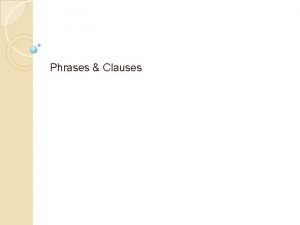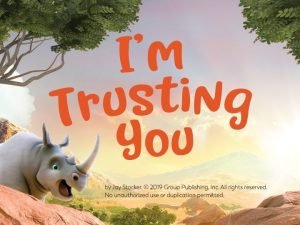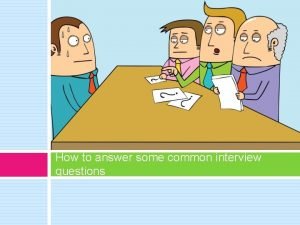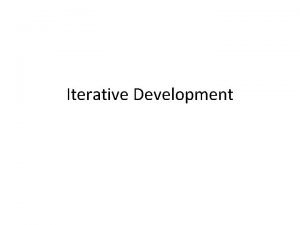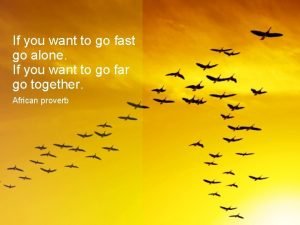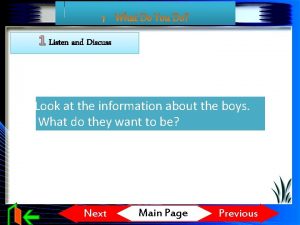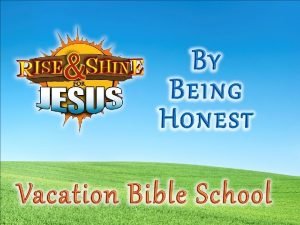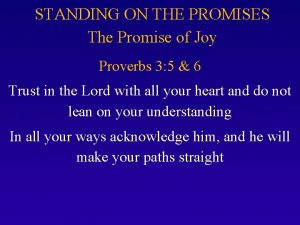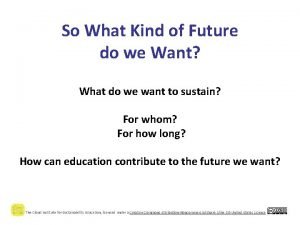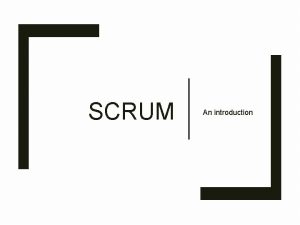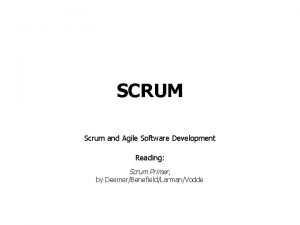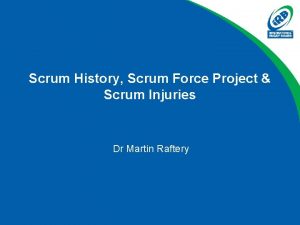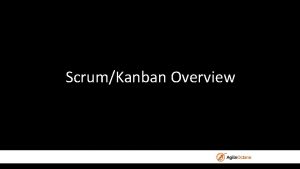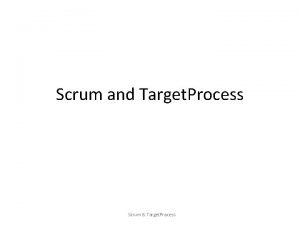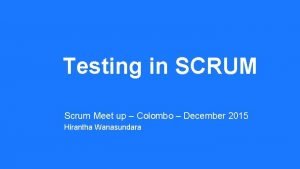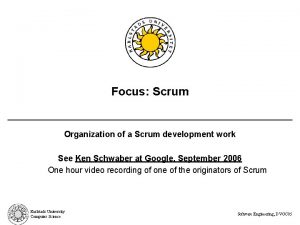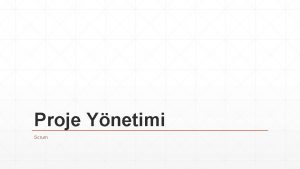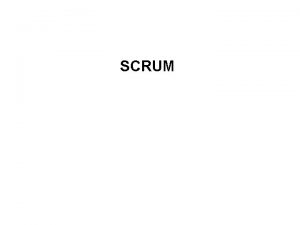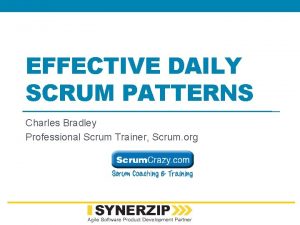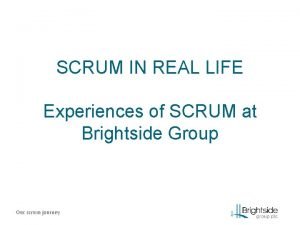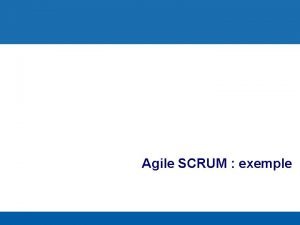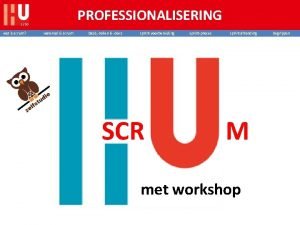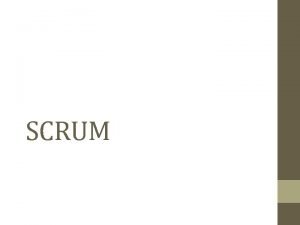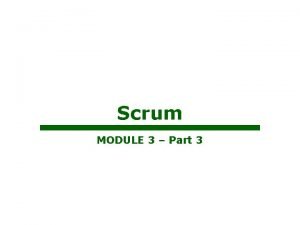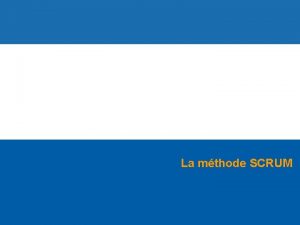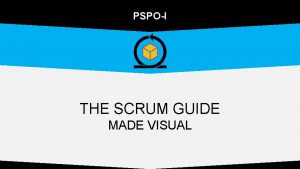An Introduction to Scrum Presented wherever you want































- Slides: 31

An Introduction to Scrum Presented <<wherever you want>> <<Date>> By <<your name>>

Scrum n “The New Product Development Game” in Harvard Business Review, 1986. n “The… ‘relay race’ approach to product development…may conflict with the goals of maximum speed and flexibility. Instead a holistic or ‘rugby’ approach—where a team tries to go the distance as a unit, passing the ball back and forth—may better serve today’s competitive requirements. ” n Wicked Problems, Righteous Solutions by De. Grace and Stahl, 1990. n First mention of Scrum in a software context

Scrum origins Scrum n Jeff Sutherland n n n Initial Scrums at Easel Corp in 1993 IDX and nearly 600 people doing Scrum Not just for trivial projects n FDA-approved, life-critical software for x-rays and MRIs n Ken Schwaber ADM n Initial definitions of Scrum at OOPSLA 96 with Sutherland n Mike Beedle n Scrum patterns in PLOPD 4 n

Scrum has been used in… Scrum n Independent Software Vendors (ISVs) n Fortune 100 companies n Small startups n Internal development n Contract development

Scrum has been used for… Scrum n FDA-approved, life-critical software for x-rays and MRIs n Enterprise workflow systems n Financial payment applications n Biotech n Call center systems n Tunable laser subsystems for fiber optic networks n Application development environments n 24 x 7 with 99. 99999% uptime requirements n Multi-terabyte database applications n Media-neutral magazine products n Web news products

Characteristics Scrum n One of the “agile processes” n Self-organizing teams n Product progresses in a series of month-long “sprints” n Requirements are captured as items in a list of “product backlog” n No specific engineering practices prescribed n Uses generative rules to create an agile environment for delivering projects

Far from Agreement Requirements Scrum Project Noise Level Close to Agreement Anarchy Complex C om pl ic at ed Simple Close to Certainty Technology Far from Certainty Source: Strategic Management and Organizational Dynamics by Ralph Stacey in Agile Software Development with Scrum by Ken Schwaber and Mike Beedle.

Scrum Overview

The Scrum Master Scrum n Represents management to the project n Responsible for enacting Scrum values and practices n Main job is to remove impediments

Scrum The Scrum Team n Typically 5 -10 people n Cross-functional n QA, Programmers, UI Designers, etc. n Members should be full-time n May be exceptions (e. g. , System Admin, etc. ) n Teams are self-organizing n What to do if a team self-organizes someone off the team? ? n Ideally, no titles but rarely a possibility n Membership can change only between sprints

Sprints Scrum n Scrum projects make progress in a series of “sprints” n Analogous to XP iterations n Target duration is one month n +/- a week or two n But, a constant duration leads to a better rhythm n Product is designed, coded, and tested during the sprint

Scrum Sequential vs. Overlapping Development Source: “The New Product Development Game”, Hirotaka Takeuchi and Ikujiro Nonaka, Harvard Business Review, January 1986.

Scrum No changes during the sprint Change Inputs Sprint Tested Code n Plan sprint durations around how long you can commit to keeping change out of the sprint

Scrum Product Backlog n A list of all desired work on the project n Usually a combination of n n story-based work (“let user search and replace”) task-based work (“improve exception handling”) n List is prioritized by the Product Owner n Typically a Product Manager, Marketing, Internal Customer, etc.

Scrum Sample Product Backlog

t en ag an M Cu s to m em er s am Te m ru Sc Pr od uc Scrum t. O wn e r Sprint Planning Meeting Product Backlog Team Capabilities Business Conditions Technology Current Product Sprint Planning Meeting Sprint Goal Sprint Backlog

The Sprint Goal Scrum n A short “theme” for the sprint: Life Sciences “Support features necessary for population genetics studies. ” Database Application “Make the application run on SQL Server in addition to Oracle. ” Financial Services “Support more technical indicators than company ABC with real-time, streaming data. ”

From Sprint Goal to Sprint Backlog Scrum n Scrum team takes the Sprint Goal and decides what tasks are necessary n Team self-organizes around how they’ll meet the Sprint Goal n Manager doesn’t assign tasks to individuals n Managers don’t make decisions for the team n Sprint Backlog is created

Scrum Sample Sprint Backlog

Scrum Sprint Backlog during the Sprint n Changes n Team adds new tasks whenever they need to in order to meet the Sprint Goal n Team can remove unnecessary tasks n But: Sprint Backlog can only be updated by the team n Estimates are updated whenever there’s new information

Scrum Sprint Burndown Chart


Daily Scrum meetings n Parameters Scrum n n n Three questions: 1. 2. 3. n What did you do yesterday What will you do today? What obstacles are in your way? Chickens and pigs are invited n n Daily 15 -minutes Stand-up Not for problem solving Help avoid other unnecessary meetings Only pigs can talk

Scrum Questions about Scrum meetings? n Why daily? n “How does a project get to be a year late? ” n “One day at a time. ” § Fred Brooks, The Mythical Man-Month. n Can Scrum meetings be replaced by emailed status reports? n No n n Entire team sees the whole picture every day Create peer pressure to do what you say you’ll do

Constraints Scrum n A complete list of constraints put on the team during a Sprint: n </end of list>

Sprint Review Meeting Scrum n Team presents what it accomplished during the sprint n Typically takes the form of a demo of new features or underlying architecture n Informal n 2 -hour prep time rule n Participants n Customers n Management n Product Owner n Other engineers

Scrum Release Sprints Sprint 1 Sprint 2 Sprint 3 Sprint 4 Sprint 1 Sprint 2 Sprint 3 Release Sprint n If necessary, during “regular” sprints target friendly first use Beta customers and similar can use immediately after sprint n During a “release sprint” n Team prepares a product for release n Useful during n n active beta periods when transitioning a team to Scrum if quality isn’t quite where it should be on an initial release n Not a part of standard Scrum, just something I’ve found useful

Scalability of Scrum n Typical Scrum team is 5 -10 people n Sutherland used Scrum in groups of 500+ n I’ve used in groups 100+

Scrum of Scrums / Meta-Scrum

Further Sources Where to go next? n Scrum n www. mountaingoatsoftware. com/scrum n www. controlchaos. com n scrumdevelopment@yahoogroups. com n Agile Software Development with Scrum n n Agile Project Management with Scrum n n Ken Schwaber and Mike Beedle General information n www. agilealliance. com

Copyright Notice n This work is licensed under the Creative Commons Attribution- Non. Commercial-Share. Alike License. To view a copy of this license, visit http: //creativecommons. org/licenses/by-nc-sa/1. 0/ or send a letter to Creative Commons, 559 Nathan Abbott Way, Stanford, California 94305, USA.
 Will follow you wherever you ...........................
Will follow you wherever you ........................... You may sit wherever you like
You may sit wherever you like I will go wherever you lead me
I will go wherever you lead me Shine wherever you go
Shine wherever you go Spoken word poetry allows you to be anyone you want to be
Spoken word poetry allows you to be anyone you want to be Project noise level scrum
Project noise level scrum Andrew chinn wherever i go
Andrew chinn wherever i go Grace nichols wherever i hang
Grace nichols wherever i hang Direct and indirect worksheet
Direct and indirect worksheet More more more i want more more more more we praise you
More more more i want more more more more we praise you More more more i want more more more more we praise you
More more more i want more more more more we praise you Why do you want to work for us
Why do you want to work for us Unit 5 grammar future time
Unit 5 grammar future time Will + infinitive
Will + infinitive So you want to be a social worker
So you want to be a social worker Favorite motto
Favorite motto Plain folks appeal
Plain folks appeal Motivated last thing you want do
Motivated last thing you want do If you want to go fast
If you want to go fast We ______ snowman in winter.
We ______ snowman in winter. Adnan: so you want to become a tennis player?
Adnan: so you want to become a tennis player? Chris burden shoot
Chris burden shoot Like a rushing wind jesus breathe within
Like a rushing wind jesus breathe within Do you want me to be honest
Do you want me to be honest Suppose you want to combine two types of fruit drink
Suppose you want to combine two types of fruit drink Helen keller overcoming obstacles
Helen keller overcoming obstacles Do you want to be made well
Do you want to be made well Keysuggest
Keysuggest Hursband
Hursband We want you
We want you If you want joy real joy wonderful joy
If you want joy real joy wonderful joy What kind of future do you want
What kind of future do you want

